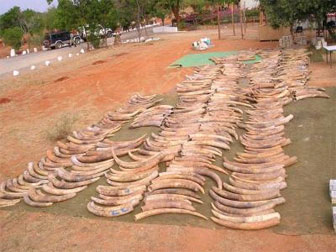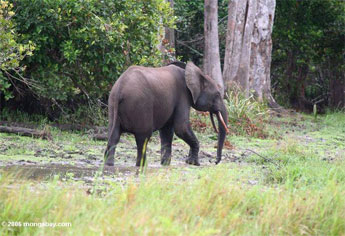Illegal elephant ivory reaches the U.S.
Illegal elephant ivory reaches the U.S.
mongabay.com
June 5, 2007
Illegally poached elephant ivory is reaching markets in the United States reports a conservation group presenting at the wildlife trade conference meeting in The Hague.
Care for the Wild International found 23,741 ivory items in surveys of stores in 15 American cities. The group said half the ivory pieces for sale in Los Angeles, San Francisco and Honolulu were imported illegally, while less than 10 percent of such goods on the east coast were illicit.
Care for the Wild International noted that the United States has been classified as an ivory trade problem country’.by the Elephant Trade Information System (ETIS), which monitors illicit movements of ivory for CITES. The U.S. has had the largest number of ivory seizures in recent years. China, Japan and Thailand are other major markets for illegal ivory.

Tusks from the second-largest contraband ivory recovery in history are laid out on the ground in Singapore after they were seized in 2002. Photo by Benezeth Mutayoba. |
“With regards to ivory trade, the U.S. fails to comply with both CITES regulations and its own national laws,” says Dr Barbara Maas, CEO of Care for the Wild. “The fact that even resource-rich countries like the United States experience these problems illustrates that legalising ivory trade means more poached elephants. It also shows that China continues to fuel this trade at home and abroad.”
Care for the Wild International’s report comes shortly after a Public Library of Science study showed increased poaching of elephants in Central Africa for the ivory trade and another paper, published in The Proceedings of the National Academy of Sciences (PNAS), found that elephants are being slaughtered at the highest rate since the international ban on the ivory trade took effect in 1989.
 Forest elephant in Gabon. Photo by Rhett A. Butler |
Samuel Wasser, director of the University of Washington Center for Conservation Biology and lead author of the PNAS study, estimated that 23,000 elephants, or about 5 percent of Africa’s total elephant population, were killed in 2006 for their ivory.
“If it really is organized crime that’s driving this, then the only hope we have of stopping it is to stop the ivory at the source, to not let it into the international market. Because once it’s in the international market, the trade is very hard to stop,” said Wasser.
Prior to the start of the Convention on International Trade in Endangered Species (CITES) meeting, the agency approved the sale of 60 tons of elephant ivory to Japan. The Associated Press reports that the sale was initially approved in 2002 but was held up until a monitoring system was developed. Some African countries, including South Africa, Botswana and Namibia, have lobbied to resume limited elephant culling for the ivory trade. Some environmentalists fear that resumption will give new life to elephant poaching.
CITES is charged with overseeing trade in wildlife products.